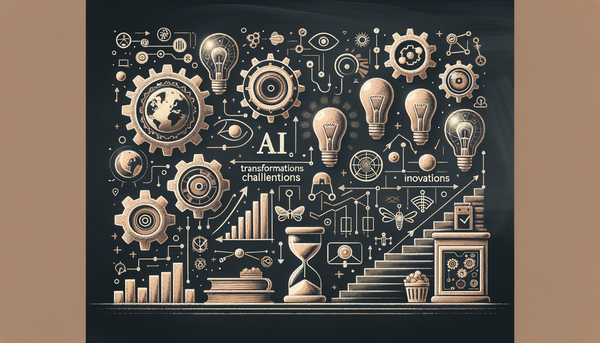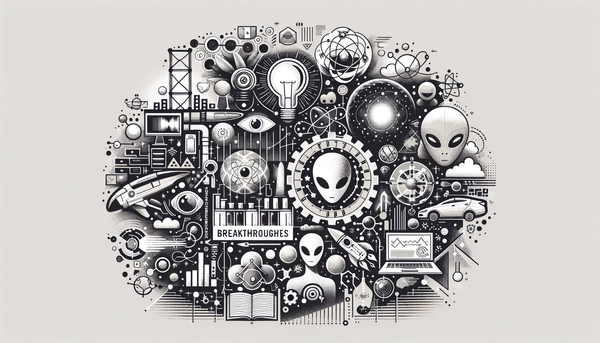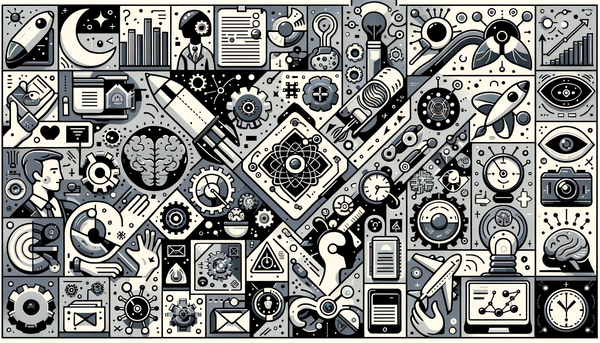Navigating Digital Identity and AI Innovations
This article explores sweeping advances and challenges in the world of Artificial Intelligence, highlighting Stability AI’s breakthrough in audio generation on Arm chips, a visionary look at Qualcomm’s integration of AI as the new mobile UI at MWC 2025, evolving user control over Apple Intelligence settings, and the increasingly troubled timeline and ambitions for Apple’s next-generation Siri. Alongside these technological developments, we delve into the societal implications of AI misuse in creating fake nudes and examine how prominent industry voices, including a Google co-founder, are driving a rigorous work ethic amid the global AI arms race.
Innovations in Audio Generation with Stability AI and Arm Chips
Stability AI is stepping boldly into the spotlight with its recent optimization of an audio generation model – now designed to run efficiently on Arm-based chips. Traditionally, many audio generators such as Suno and Udio have relied upon cloud processing to produce sound effects and music, limiting offline capabilities. However, by harnessing an entirely royalty-free training data set and focusing on in-device processing, Stability AI’s approach is redefining expectations.
Nearly revolutionary in nature, the new Stable Audio Open model claims a 30-fold speed improvement in generating audio clips. Imagine being able to produce an 11-second clip in just eight seconds with the new Armv9 CPU optimizations – a feat that significantly cuts down latency and opens up avenues for creative applications on mobile devices. Soon, we might see this innovation power next-generation mobile creativity apps, live audio filters, and even assistive technologies in real time.
This development is particularly exciting because it transforms how audio generation is perceived: no longer is the cloud the sole savior of advanced processing; hardware optimization paired with smart AI design is making real-time audio synthesis not only possible but practical. The integration of AI models directly within the device ecosystem promises greater privacy – by keeping data and computation local – and a reduction in the reliance on high-speed internet connectivity.
As Stability AI’s CEO, Prem Akkaraju, has hinted, the work done in optimizing these models is just the beginning. The move not only paves the way for enhanced user experiences but also strengthens the company’s competitive edge after some tumultuous periods marked by earlier missteps.
The collaboration between Stability AI and Arm also signals a broader industry trend toward embracing edge computing capabilities. Developers and researchers are now noticing that optimized models can be deployed in numerous consumer and industrial applications, from gaming soundscapes to advanced auditory feedback in navigation systems.
In many ways, this breakthrough illustrates how AI can merge seamlessly with everyday technology – not as a distant cloud-bound service, but as a tangible, rapidly responsive feature on a device that fits snugly in your pocket.
AI Revolutionizing Mobile User Interfaces: Qualcomm at MWC 2025
In tandem with innovations like Stability AI's breakthrough, the mobile industry is undergoing its own AI revolution. At Mobile World Congress (MWC) 2025, Qualcomm is positioning AI as the new frontier for mobile user interfaces. While many of us have grown accustomed to tapping icons and swiping screens, Qualcomm’s work hints at a future where AI-driven conversations and intelligent reactions could replace many conventional UI interactions.
The idea behind incorporating AI directly into the mobile UI is both visionary and grounded in the demand for more intuitive user experiences. Imagine a phone that doesn’t just respond to your taps but actively anticipates your needs based on context and behavior. Whether it’s suggesting an app based on your routine or intelligently predicting the best route on your morning commute, artificial intelligence is poised to redefine personal connectivity.
This shift towards an AI-centric mobile interface isn’t happening in a vacuum. It dovetails with broader trends across the tech landscape where machine learning models are increasingly being deployed at the edge – on mobile chips – to provide personalized personalization and faster response times. Qualcomm’s proactive strategy, as reported in recent coverage from ComputerWeekly.com, ties into an industry ethos of blending computational innovation with enhanced user engagement.
As with any pioneering effort, the introduction of AI within mobile UIs brings with it inevitable challenges, such as ensuring privacy, mitigating biases in data, and calibrating the balance between automation and user control. Nonetheless, the potential benefits – a more natural user experience and smarter, context-aware services – present a compelling rationale for moving forward.
This evolving scenario reminds me of a quote by Stephen Hawking:
“Artificial intelligence is a tool, not a replacement for human intelligence.”
As we look at Qualcomm’s approach, it is clear that while technology is advancing at breakneck speeds, the harmonious integration of AI into everyday life will always require a human-centric, mindful approach.
Navigating the Apple Ecosystem: Controlling and Customizing Apple Intelligence
While Qualcomm drives innovation on the hardware front, Apple is making strides in a slightly different direction by putting more control in the hands of users through enhanced Apple Intelligence settings. Reports highlighted by TechRadar emphasize that users are increasingly interested in managing how their devices interpret and utilize AI, ensuring that functionalities align with individual preferences and privacy concerns.
The capability to adjust Apple Intelligence settings is a welcome feature, particularly against a backdrop of mounting debates around data privacy and the ethical implications of AI. Many people find reassurance in having a say in how much their behavior, personal data, and device interactions are leveraged by machine learning algorithms. This empowerment aligns with a broader consumer demand for transparency and fairness.
Furthermore, these settings are not merely about toggling features on or off; they represent a strategic shift toward a more accountable, user-centric AI ecosystem. For instance, adjusting the scope of data collection or how predictive analytics operate on a device can not only enhance user experience but also mitigate potential misuse of personal information.
In this context, Apple’s proactive communication about these controls is important for cultivating a trusting relationship with its diverse user base. By giving people the reins to manage their own AI experience, Apple is setting the stage for a more nuanced conversation about the balance between cutting-edge technology and user sovereignty.
Indeed, as we navigate the intricacies of modern AI, this balancing act will remain critical – a reminder that even as innovation rockets forward, the human element must never be sidelined.
The Future of Siri: Ambitions, Delays, and the Competitive AI Landscape
Perhaps one of the most talked-about subjects in the realm of virtual assistants is the future of Siri. Apple’s ambitious new initiative, Apple Intelligence, was meant to catapult the digital assistant into a next-generation conversational partner. However, as reported recently on Macworld, the timeline for these transformational changes has become significantly protracted, with the next major evolution of Siri now projected to appear in 2027.
The delay stems not only from technical challenges and persistent bugs but also from internal resource constraints. Dubbed “LLM Siri” internally, this upgraded version aims to imbue the assistant with a fuller, more natural conversational tone. Yet as Apple grapples with integrating advanced language models while maintaining reliability, the development process has become a quagmire.
The implications of this delay extend far beyond a simple timeline setback. With competitors like Google and Amazon refining their digital assistants on a more aggressive schedule, Apple’s struggles could signal a larger strategic challenge in staying relevant in a rapidly evolving market. Some observers, including industry insiders, point out that the prolonged development cycle might hinder Apple’s ability to compete effectively, potentially ceding ground to its rivals in the AI arms race.
In a manner reminiscent of broader technological disruptions throughout history, Apple’s journey with Siri illustrates the complex interplay between ambition and execution. While the promise of a voice assistant that can seamlessly converse and understand natural language has captured public imagination for years, the reality of developing such technology is marked by setbacks, refinements, and often unforeseen technical hurdles.
One can recall the sentiment voiced by tech analysts: innovation rarely follows a linear path. Instead, it is more like a winding road with plenty of stops, recalibrations, and detours. For instance, even as we celebrate the promise of contemporary AI, we must acknowledge the obstacles inherent in the development process – a reality that Apple is now navigating with a blend of optimism and caution.
As a case in point, Mark Gurman has pointed out the growing uncertainty around Siri’s future, suggesting that this delayed timeline may indeed stretch Apple’s promise of a “modernized” digital assistant into a new era. This scenario serves as a critical reminder that even the most well-resourced tech giants are not immune to the complexities of next-generation AI development.
Societal Implications: Confronting the Reality of AI-Generated Fake Nudes
Beyond the realm of device optimization and digital assistants, AI is simultaneously pushing us to confront challenging societal issues. A recent article from Ars Technica has brought to the forefront the emotional and ethical dimensions of AI misuse in generating fake nudes – a phenomenon that, while technologically intriguing, raises serious concerns about consent, privacy, and digital reputation.
The article, provocatively titled “It’s not actually you”: Teens cope while adults debate harms of fake nudes, reflects a multifaceted debate. On one hand, teenagers, who are often at the epicenter of digital trends, articulate strategies for coping with the unintended consequences of AI-generated images that misrepresent reality. On the other hand, adults and policymakers are struggling to find a balance between rapid technological innovation and the ethical frameworks necessary to safeguard vulnerable users.
This issue is emblematic of a broader societal challenge: as advanced machine learning models become more accessible, the potential for misuse escalates. While tools that generate hyper-realistic images can drive exciting innovations in art and media, they simultaneously have the potential to undermine trust and distort social realities.
It is worth recalling the thought expressed by Gray Scott:
"The real question is, when will we draft an artificial intelligence bill of rights?"
Such reflections underscore the urgency with which regulators, technology companies, and communities must come together to address these emerging risks.
As we advance further into this digital age, the integration of AI into society demands ethical oversight as much as it does technical ingenuity. In this context, educational initiatives, robust legal frameworks, and proactive community discussions become crucial in mitigating the darker sides of technological innovations.
Ultimately, the dialogue around AI-generated fake nudes serves as a cautionary tale – a vivid reminder that the march of technological progress must be accompanied by an equally rigorous commitment to ethical standards and human values.
Work Ethic and the AI Arms Race: Lessons from a Google Co-Founder
Alongside these technological and ethical conversations, another interesting narrative is unfolding in boardrooms and tech labs around the globe. An intriguing report suggests that a Google co-founder is advocating for a rigorous 60-hour work week to keep pace with the accelerating AI arms race. Although details around this call to heightened work commitments remain sparse, it undeniably sheds light on the intense competitive pressures pervading the tech sector.
In an era where breakthroughs occur at a rapid pace, the call for longer working hours hints at a culture of relentless innovation – one that places enormous expectations on engineers and data scientists. This perspective, while controversial, reflects a broader sentiment in the tech community where passion for discovery is sometimes accompanied by the strain of unrealistic timelines.
It’s essential to recognize that such assertions provoke a broader discussion about work-life balance, employee well-being, and the future of innovation. As much as a 60-hour work week might escalate the pace of development, it also raises critical questions about sustainability and the potential human cost of technological advancement.
In this context, leaders such as Reed Hastings have emphasized that “AI is a tool that will make our society more connected, more efficient, and more productive. We need to understand its implications and use it wisely.” Such perspectives advocate for a balanced approach – one where technological ambition is tempered by the acknowledgment of human limitations and the need for ethical practices.
This ongoing debate serves as both a rallying cry and a cautionary note for the industry. As companies race to be first to market with groundbreaking AI applications, it remains vital to maintain a standpoint that values sustainable innovation over short-term gains.
Looking Ahead: AI’s Embedded Future in Everyday Technology
Stepping back to view the broader landscape, one can appreciate the intricate tapestry of innovation and adaptation that defines today’s AI scene. The rapid progress witnessed in mobile computing, digital assistants, ethical debates, and work cultures is not simply a series of isolated developments – they are interconnected threads in a dynamic technological narrative.
On one hand, the achievement by Stability AI in optimizing audio generation for Arm chips lays a robust foundation for real-time, on-device intelligence. This breakthrough not only marks a significant improvement in performance but also champions a shift away from an over-reliance on cloud services, thereby enhancing privacy and accessibility.
On the other hand, industry behemoths like Apple are faced with the dual challenge of pioneering advancements in AI – as seen with the contentious evolution of Siri – while ensuring that users retain control over their data and digital experiences. These challenges are compounded further by a rapidly evolving competitive landscape, where even giant companies must continually innovate to keep pace.
Beyond the tech giants, the societal ramifications of AI innovations – such as the fallout from fake nudes and discussions surrounding digital rights – highlight the importance of coupling technological progress with ethical oversight. AI’s growing influence in our daily lives demands that we remain vigilant about its potential for both empowerment and misuse.
It’s a scenario reminiscent of historical technological leaps: the advent of the printing press, the industrial revolution, and the emergence of the internet each brought transformative change, accompanied by both exhilaration and apprehension. Today, Artificial Intelligence occupies that same critical juncture, with the promise of unprecedented benefits shadowed by ethical, social, and practical challenges.
In reflecting on these multifaceted dynamics, I am reminded of a familiar proverb: "With great power comes great responsibility." Whether it is about reimagining user interfaces, accelerating audio synthesis, or safeguarding against the adverse impacts of AI misuse, the responsibility lies with engineers, policymakers, and society at large to harness these innovations genuinely and thoughtfully.
As the dialogue around AI evolves, it is clear that the future of technology is not just about smarter algorithms or faster processing – it’s about creating systems that enrich human experience, foster innovation responsibly, and ultimately serve the broader good of society.
Further Readings and Perspectives
For those interested in exploring these topics further, consider reviewing the detailed report on Stability AI’s optimized audio generation model available on TechCrunch. A deep dive into the evolution of digital assistants and the challenges faced by Apple can be found on Macworld, while the ethical debate surrounding AI-generated content is thoughtfully discussed in an article on Ars Technica.
Additionally, insights into how mobile tech is embracing AI integration can be further explored through coverage by ComputerWeekly.com on “MWC 2025: AI is the new mobile UI for Qualcomm,” and for those interested in personalizing their device settings, TechRadar’s guide on changing Apple Intelligence settings offers valuable advice.
These diverse narratives, when taken together, provide a panoramic view of how artificial intelligence is reshaping industries, user experiences, and societal norms. As we stand on the threshold of a new era in technology, it is the interweaving of innovation, ethical responsibility, and informed debate that will ultimately chart the path forward.
Concluding Reflections
In wrapping up our exploration of these diverse AI developments, it becomes evident that the journey toward an integrated AI future is as complex as it is promising. Whether through on-device optimizations, the reimagining of mobile interfaces, or the balancing act between innovation and ethics, each facet of the discussion contributes to a broader conversation about technology’s role in modern society.
As we move forward, it is essential to remember that while AI holds the potential to make our lives more connected, efficient, and dynamic – it also requires responsible stewardship from every stakeholder involved. Embracing a balanced perspective that champions both innovation and the human values that underlie all technological progress will be key.
After all, as we harness and refine these powerful tools, we must always remain mindful of the timeless wisdom that innovation is at its best when it serves to elevate the human experience.




